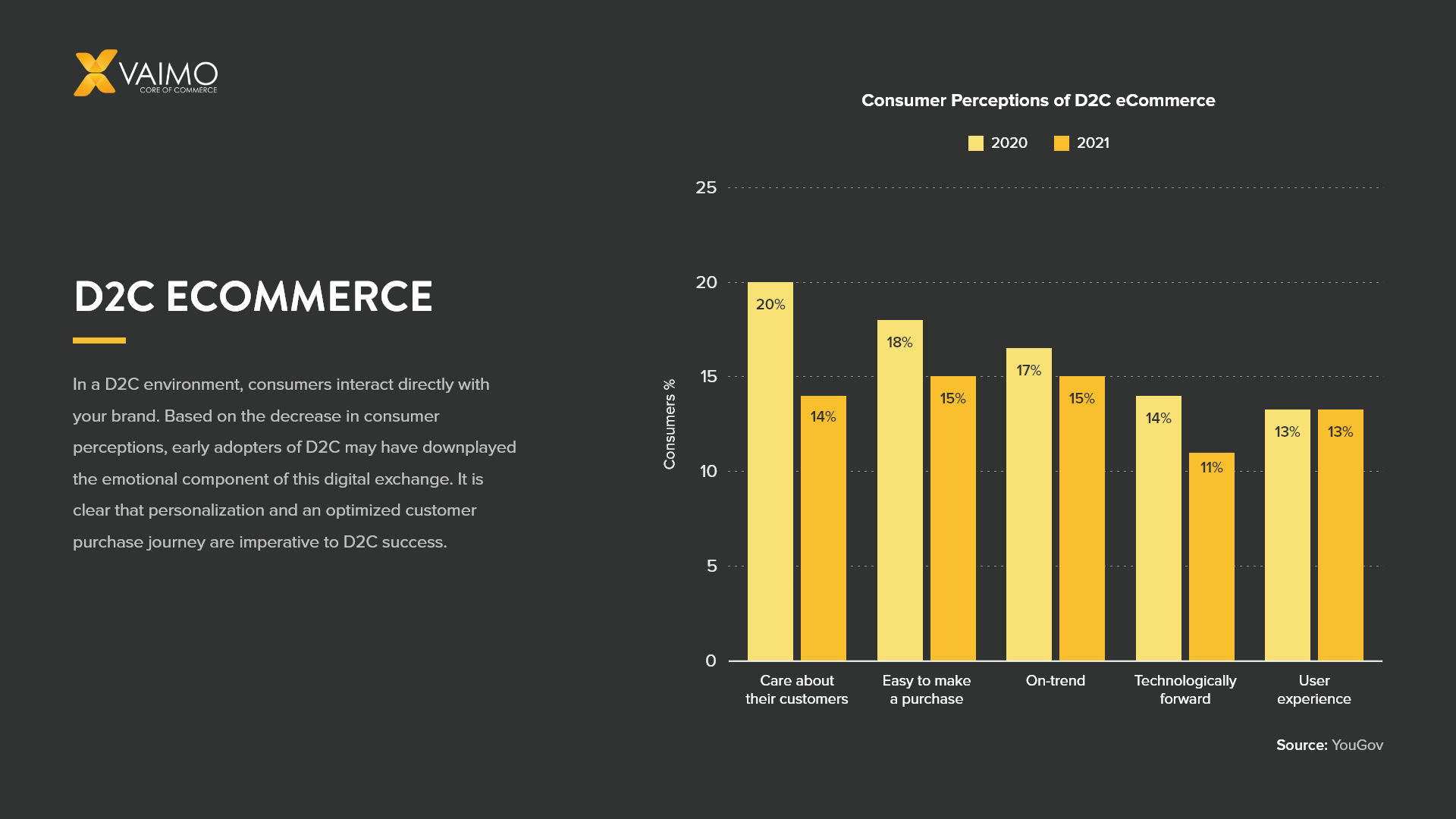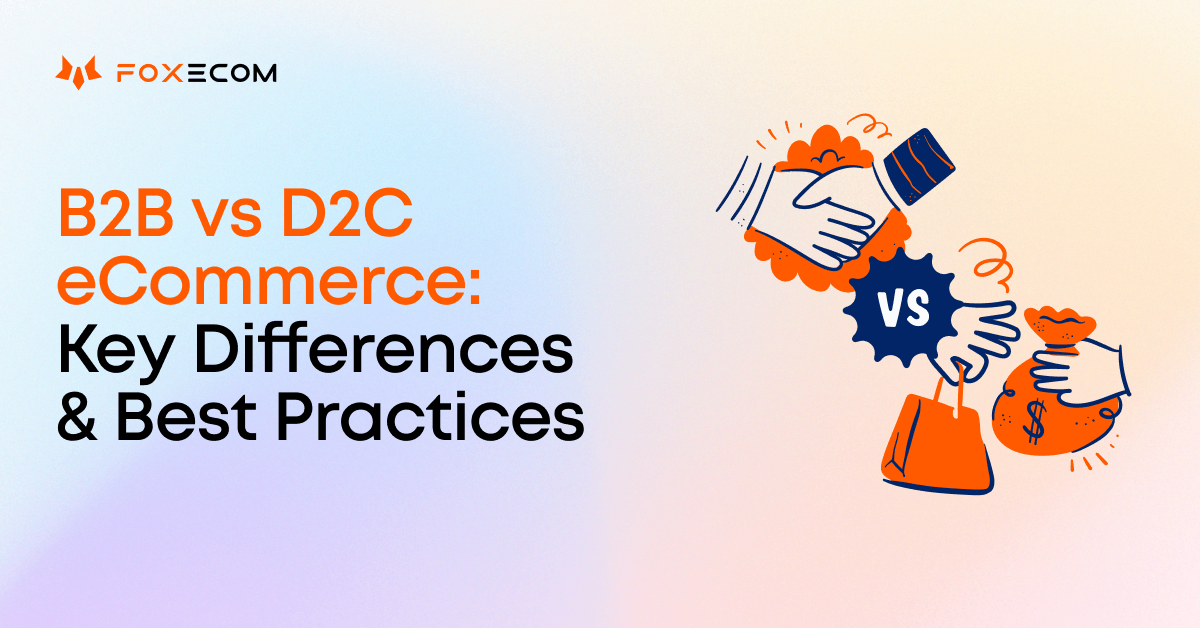How a D2C Ecommerce Agency Can Help You Expand to Global Markets
Discovering the Prospective of D2C Ecommerce: A Comprehensive Overview for Businesses
The D2C ecommerce version offers a significant change in just how brand names engage with customers. It makes it possible for firms to bypass typical retail channels, promoting much deeper links and potentially boosted profit margins. This approach is not without its complexities. Understanding the nuances of D2C ecommerce is vital for brands intending to flourish. What approaches can they embrace to browse this advancing landscape properly? The answers may redefine their business approaches.
Comprehending the D2C Ecommerce Design

Key Advantages of D2C Ecommerce for Brands
The D2C ecommerce design uses brands considerable advantages, especially relating to boosted earnings margins. By removing middlemans, firms can retain a larger share of sales revenue. Furthermore, this direct connection with consumers promotes improved brand commitment, motivating repeat purchases and long-term involvement.
Enhanced Earnings Margins

Enhanced Brand Loyalty
Structure on the financial advantages of D2C ecommerce, boosted brand name loyalty becomes one more essential benefit for companies involving straight with customers. By establishing a direct connection, brands can foster much deeper relationships with their customers, obtaining understandings right into choices and actions. This direct communication enables for even more tailored advertising and marketing strategies, which reverberate strongly with consumers. Additionally, brand names have the opportunity to manage their messaging and customer experience, strengthening brand name worths and constructing trust fund. When customers feel a personal connection, they are most likely to return, advocate for the brand, and take part in area involvement. Inevitably, enhanced brand loyalty not just drives repeat acquisitions but likewise cultivates an enthusiastic consumer base, more solidifying a brand name's placement in the market.
Challenges Dealt With by D2C Brands
D2C brands experience several significant difficulties that can impact their success. Stock monitoring issues can cause stock shortages or excess, complicating procedures and client fulfillment. In addition, marketing budget constraints frequently restrict the capacity to properly involve and reach target audiences.
Inventory Administration Issues
Efficient supply management presents an awesome challenge for numerous brands running in the direct-to-consumer (D2C) room. These brand names commonly grapple with varying need, which can cause overstock or stockouts, inevitably impacting consumer complete satisfaction and earnings. In addition, the lack of advanced supply tracking systems can result in disparities in between real stock levels and reported data, complicating order gratification. The varied variety of items D2C brand names generally provide additionally makes complex inventory monitoring, as variants in shades, dimensions, and designs need even more careful oversight. Additionally, lots of D2C companies may struggle with minimal warehousing capabilities, leading to ineffective use area and sources. Subsequently, efficient stock monitoring stays an essential obstacle for D2C brand names intending for lasting development and operational effectiveness.
Advertising And Marketing Budget Constraints
Navigating advertising and marketing spending plan constraints is a significant obstacle for many direct-to-consumer (D2C) brand names. Restricted funds commonly restrict these business' ability to purchase all-inclusive advertising and marketing techniques, causing minimized visibility in an open market. D2C brand names frequently come to grips with the need to maximize return on financial investment (ROI) while targeting particular audiences properly. This difficulty is exacerbated by climbing costs in electronic marketing and the necessity to assign funds across numerous channels, consisting of social networks, search engines, and e-mail advertising and marketing. Several D2C brand names have to introduce affordable advertising and marketing solutions, leveraging natural growth approaches and influencer partnerships. Eventually, successfully maneuvering these spending plan constraints is important for sustaining development and achieving lasting productivity in the progressing ecommerce landscape.
Techniques for Constructing an Effective D2C Ecommerce Business
As consumers significantly look for straight connections with brands, establishing an effective D2C ecommerce service requires a calculated technique that focuses on customer involvement and depend on. recommended you read One reliable technique is to produce compelling brand stories that reverberate with target audiences, fostering emotional connections. Making use of social networks systems can enhance exposure and help with two-way communication, enabling brands to engage directly with customers.Moreover, personalized experiences via customized marketing initiatives can significantly enhance customer retention and loyalty. Carrying out commitment programs and supplying exclusive bargains can further incentivize repeat purchases.Streamlining the buying procedure is essential, guaranteeing an user-friendly user interface that improves the shopping experience. Furthermore, transparent communication regarding shipping and returns develops trust and urges consumer confidence.Finally, proactively seeking consumer responses and reacting to it demonstrates a commitment to improvement and consumer contentment, crucial aspects in the competitive D2C landscape.
Leveraging Technology for Improved Customer Experience
In today's competitive D2C ecommerce landscape, technology plays a crucial function in shaping client experiences. Businesses increasingly make use of innovative tools such as synthetic intelligence, chatbots, and customized formulas to improve communications and simplify the buying process. By integrating these innovations, brands can give customized product referrals based on private choices and buying actions, cultivating a more engaging experience.Moreover, receptive web site layouts and mobile applications assure that customers can access solutions perfectly throughout numerous devices. Enhanced settlement options, including electronic budgets and one-click checkouts, additionally streamline purchases, making it simpler for consumers to make purchases.Data analytics additionally enables businesses to gather insights right into customer behavior, enabling continual renovation of offerings and services. On the whole, leveraging modern technology not just boosts consumer satisfaction yet additionally grows commitment, ultimately driving lasting success in the D2C ecommerce industry.
Advertising Strategies to Drive D2C Sales
How can brands properly capture the interest of consumers in a saturated market? To grow in the direct-to-consumer (D2C) landscape, brands need to use targeted advertising and marketing strategies. Making use of social media platforms, brands can involve consumers via interactive web content, influencer web partnerships, and user-generated posts. Customized e-mail projects can additionally promote a sense of link, using tailored promotions based upon consumer behavior and preferences.Moreover, narration plays a crucial function in distinguishing a brand's narrative, making it memorable and relatable. Brand names should spend in seo (SEO) to enhance presence, ensuring their products are easily visible online. In addition, leveraging data analytics permits services to refine their advertising strategies and understand consumer trends much better. Ultimately, a multi-channel strategy that incorporates imagination with data-driven understandings can substantially increase D2C sales, allowing brands to stick out in a congested marketplace.
Future Patterns in D2C Ecommerce
With the quick development of technology and consumer choices, the future of D2C ecommerce is positioned for considerable makeover. Emerging patterns show a change towards hyper-personalization, where brand names leverage information analytics to tailor offerings to individual customer requirements. This modification enhances client experiences, promoting loyalty and engagement.Moreover, sustainability is becoming a vital aspect, with customers progressively favoring brand names that focus on eco-friendly methods - D2C Ecommerce Agency. Companies are anticipated to adopt clear supply chains and lasting products to satisfy this demand.The assimilation of man-made intelligence and increased truth will furthermore revolutionize the purchasing experience, enabling customers to visualize items in their settings before purchase. On top of that, social business is anticipated to expand, as platforms like Instagram and TikTok facilitate seamless purchasing experiences straight within social media.These fads jointly signify a dynamic future for D2C ecommerce, stressing customer-centric methods and cutting-edge modern technologies that redefine customer communications
Frequently Asked Questions
What Industries Advantage A Lot Of From D2C Ecommerce?
The existing concern highlights sectors that prosper through direct-to-consumer (D2C) ecommerce. Extremely, style, charm, electronics, and food markets utilize D2C models to boost brand commitment, enhance client connections, and optimize revenue margins successfully.
Exactly How Do Shipping Prices Affect D2C Rates Approaches?
Shipping costs significantly influence D2C pricing methods. Services have to balance these expenses with affordable pricing, thinking about customer assumptions and earnings margins. Reliable administration of delivery can improve customer fulfillment and drive sales in direct-to-consumer versions.
What Settlement Choices Should D2C Services Offer?
D2C hop over to here organizations must use diverse settlement alternatives, consisting of credit/debit cards, digital wallets, and get now, pay later services. This selection enhances consumer comfort, raises conversion prices, and accommodates different consumer preferences in the online buying landscape.
How Can D2C Brands Manage Consumer Returns Effectively?
D2C brand names can handle customer returns properly by carrying out straightforward return policies, supplying prepaid delivery labels, and making certain timely refunds (D2C Ecommerce Agency). Clear communication and streamlined procedures boost consumer satisfaction and motivate repeat organization
What Legal Considerations Exist for D2C Ecommerce Procedures?
Lawful considerations for D2C ecommerce operations include conformity with consumer protection laws, information personal privacy guidelines, intellectual residential or commercial property civil liberties, and tax needs. Brand names should navigate these intricacies to stay clear of legal risks and ensure smooth procedures. By eliminating middlemans, D2C brands can provide affordable rates and foster a more intimate connection with their customers.The D2C design is identified by its reliance on digital systems, enabling brand names to utilize social media, on-line markets, and their very own sites to engage with consumers straight. D2C ecommerce promotes the collection of important consumer data, enabling brand names to tailor their offerings and advertising techniques effectively, inevitably driving sales and increasing margins. Furthermore, brands have the chance to control their messaging and client experience, enhancing brand values and constructing trust. As customers increasingly seek straight connections with brands, developing a successful D2C ecommerce service needs a critical method that prioritizes customer engagement and count on. D2C brand names can handle client returns successfully by implementing easy to use return policies, offering pre-paid delivery tags, and making certain punctual reimbursements.